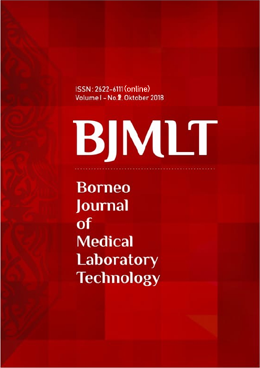Rasio AST/ALT pada Laki-Laki Pengkonsumsi Alkohol di Jalan Mendawai Kota Palangka Raya
AST/ALT Ratio on Alcohol Consumption Men in Mendawai Street Palangka Raya
DOI:
https://doi.org/10.33084/bjmlt.v1i2.710Keywords:
AST, ALT, AST/ALT Ratio, Alcoholic liver diseaseAbstract
Aspartate aminotransferase (AST) and Alanine aminotransferase (ALT) are enzymes predominantly found in hepatocytes, the increased activity in the serum shows liver damage. The AST / ALT ratio is used as a marker for alcoholic liver disease. This study aims to determine the effects of long-term alcohol consumption on the risk of alcoholic liver disease. This study was a descriptive study, involving 20 alcoholic drinkers aged 25-45 years, had consumed alcohol> 5 years and consumed alcohol every day. Our results showed a significant increase (p <0.05) in AST and ALT values based on age group, duration of consumption and dose. While the ratio of AST / ALT, a significant increase was found in the age group and period. In alcohol drinkers, the AST value is higher than ALT. The AST / ALT ratio for heavy drinkers is 1.64. Conclusion: Alcohol-consuming subjects in our study, especially heavy drinkers, were suspected of having a risk of alcoholic liver disease because most had an AST / ALT ratio > 1,5.
Downloads
References
Botros, M. et al. 2013. The De Ritis Ratio : The Test of Time. Clin Biochem. 34: 117–130.
Dakeishi, M. et al. 2004. Effects of Alcohol Consumption on Hepatocellular Injury in Japanese Men. The Tohoku Journal of Experimental Medicine. 202(1): 31–39.
Dguzeh, U. et al. 2018. Alcoholism: A multi-systemic cellular insult to organs. International Journal of Environmental Research and Public Health. 15(6).
Gao, B. and Bataller, R. 2011. Alcoholic Liver Disease: Pathogenesis and New Therapeutic Targets. Gastroenterology. 141(5): 1572–1585
Hardjoeno H. 2003. Interpretasi Hasil Tes Laboratorium Dan Diagnostic. Universitas Hasanudin : Makasar
King, MW. 2017. Ethanol Metabolism. Available at:https://themedicalbiochemistrypage.org/ethanol-metabolism.php diakses pada 15 April 2019
Mcdonald, H. et al. 2013. Comparative performance of biomarkers of alcohol consumption in a population sample of working-aged men in Russia: The Izhevsk Family Study. Addiction. 108(9): 1579–1589
Purbayanti, D., dan Saputra, N. A. R. 2017. Efek Mengkonsumsi Minuman Beralkohol Terhadap Kadar Triglisrida. Jurnal Surya Medika (JSM). 3(1): 75-81
Shreevastva, N. K., Pandeya, A. and Mishra, D. K. 2017. A study of AST : ALT ratio in alcoholic and nonalcoholic liver diseases’, Saudi Journal of Medical and Pharmaceutical Sciences, 49 (29): 1047–1050.
Singal, A. K. et al. 2018. ACG clinical guideline: Alcoholic liver disease. American Journal of Gastroenterology. Nature Publishing Group, 113(2): 175–194
Steiner, J. L. and Lang, C. H. 2017. Alcohol, adipose tissue and lipid dysregulation. Biomolecules.
Thursz, M. et al. 2018. EASL Clinical Practice Guidelines: Management of alcohol-related liver disease. Journal of Hepatology. European Association for the Study of the Liver. 69(1): 154–181.
World Health Organisation and Management of Substance Abuse Team (2018) Global status report on alcohol and health 2018., World Health Organisation. doi: /entity/substance_abuse/publications/global_alcohol_report/en/index.html.
Wu, C.-Y. et al. 2010. Relationship Between Blood Alcohol Concentration and Hepatic Enzymes in an Emergency Department. Tzu Chi Medical Journal. Buddhist Compassion Relief Tzu Chi Foundation. 22(1): 24–28
Xu, Q., Higgins, T. and Cembrowski, G. S. 2015. Limiting the Testing of AST. American Journal of Clinical Pathology. 144(3): 423–426
Downloads
Published
How to Cite
Issue
Section
License
All rights reserved. This publication may be reproduced, stored in a retrieval system, or transmitted in any form or by any means, electronic, mechanical, photocopying, recording.












